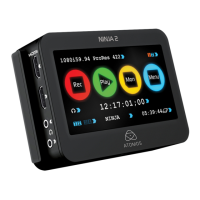Atomos Ninja-2 – User Manual Edition 1: November 2012 5
2. What you also need
HDMI cables (not included)
There’s a lot of mythology about
HDMI cables. Most people can’t
tell the difference in picture quality
between expensive ones and
cheaper ones. There shouldn’t be
any difference if as long as all the
digits going through the cable arrive at the other end. And yet some
supposedly “top end” cables can cost hundreds of times more than you
necessarily have to spend. It is rare to get a cable that is bad enough to
affect the picture, but keep in mind that the longer the cable, the more
likely it is to cause problems.
There is at least one good reason for spending a bit more on an HDMI
cable: the physical quality.
HDMI was designed as a living-room standard. So most cables are
designed to be fitted behind TVs and rarely moved.
That’s completely different to the type of use they will get with the Ninja,
when they will be moved all the time and need to be strong but flexible.
Some of the cheaper HDMI cables might work properly but are almost
completely inflexible.
Flexible cables will put less strain on the HDMI sockets on your camera
and on your Ninja-2 - but, in any case, it is worth considering some
kind of cable management (cable ties or clips) near each HDMI socket -
especially since HDMI is not a “locking” connection.
Some cameras and camcorders use a “mini” HDMI connection to save
space. Cables with a mini connection at one end and a standard one at
the other end are freely available.
If the HDMI cable is removed while recording the “Skippy”
image will also be displayed. To remove touch skippy and he
will disappear ready for his next notification.
Refer to Part 8: Atomos Anti-skip Technology for more
information about “Skippy”.
Standard 1/4” Camcorder Mount
This must fit a standard 1/4” screw mount. Select the type
that best suits your application and conditions.

